Elasticsearch
Elasticsearch is a robust search engine designed for quick and efficient data retrieval in applications. It handles diverse data types, employs a distributed architecture, and offers a powerful query language for real-time search needs. Integration into your applications enhances search experiences, enabling developers to implement efficient full-text searches and complex queries. Elasticsearch’s indexing capabilities make it valuable for applications such as monitoring systems, log analysis tools, and other scenarios requiring fast and relevant data access. Below is a video for our OpenSearch functionality, which can be used as a reference when working with our Elasticsearch functions; they are largely the same.Connect to Elasticsearch
Requires an Elasticsearch domain.auth_type
Choose betweenBasic,BearerorAPI Keyto set the type of authentication process to use.key_id
If usingBasic, enter the username you wish to authenticate with.
If usingBearer, leave this blank.
If usingAPI Key, enter the API key identifier you wish to authenticate with.access_key
If usingBasic, enter the API key secret you with to authenticate with.
If usingBearer, no access key is required.
If usingAPI Key, enter the value that corresponds with the key identifier you wish to authenticate with.base_url
Set to the domain endpoint where Elasticsearch is hosted.index
Enter the name of the Elasticsearch index to send request.
Only applicable on Document and Query functions.
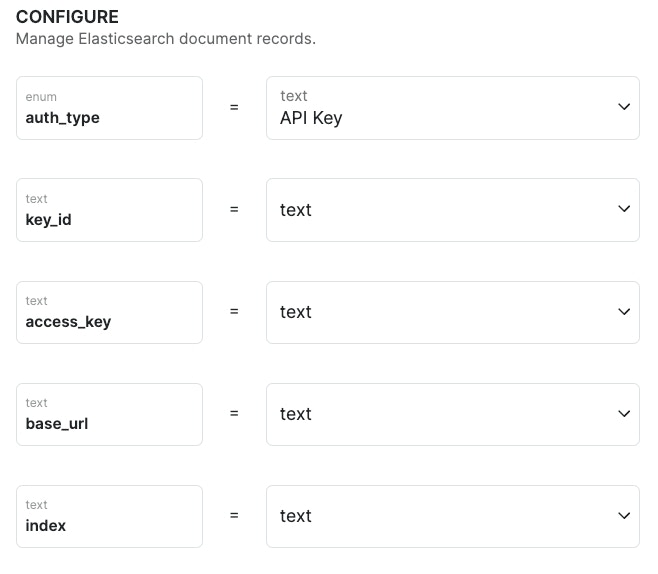
Elasticsearch Query Wizard Function
Use the query wizard to easily search documents stored in Elasticsearch.Configure
See Connect to Elasticsearch for details on configuration. Then, select areturn_type from the options below.
search- Returns records that match querycount- Returns number of total records matching query
Query
Query Wizard Set filter criteria using the Xano query builder. The left input is the field to filter on. Then set the operator and value to evaluate. Optionally, add multiple conditions using AND / OR logic. Select ‘Update Payload’ to ensure your changes are reflected in the query payload.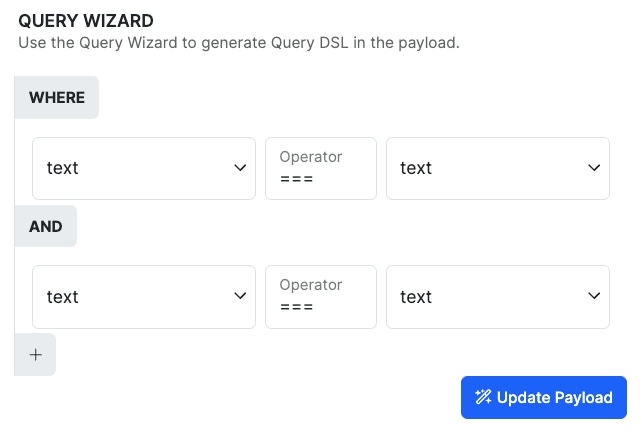
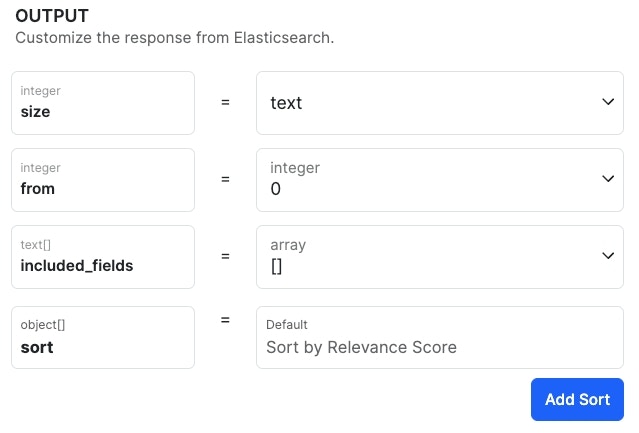
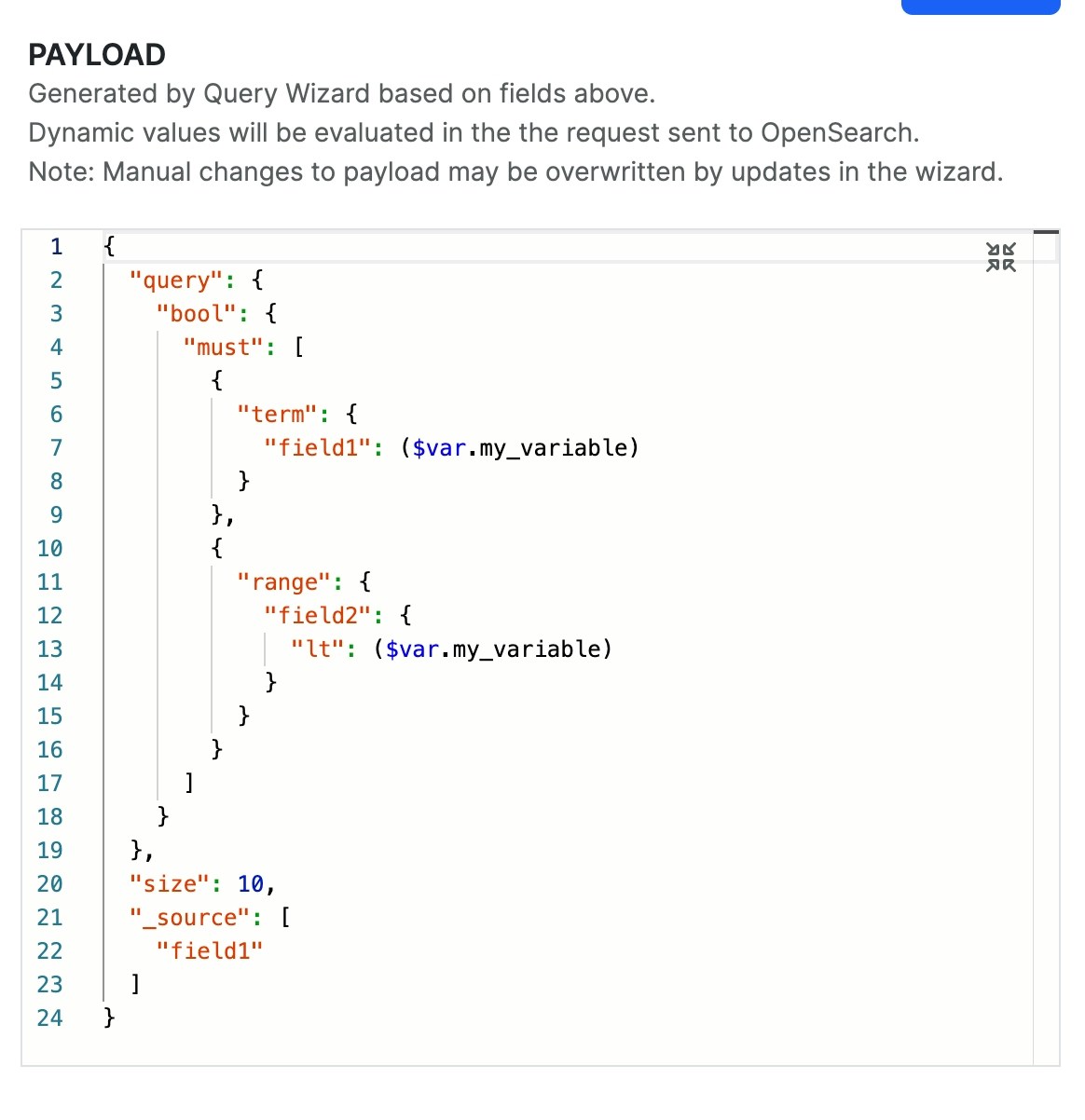
Elasticsearch: Document (CRUD) Function
Easily get, add, update, or remove documents from an Elasticsearch index.Configure
See Connect to Elasticsearch for details on configuration.Get Document
- Set method of API request to GET
- Specify doc_id

Create or Update Document
- Set
methodtoPOST(create) orPUT(update) - Set
doc_id(optional for POST)
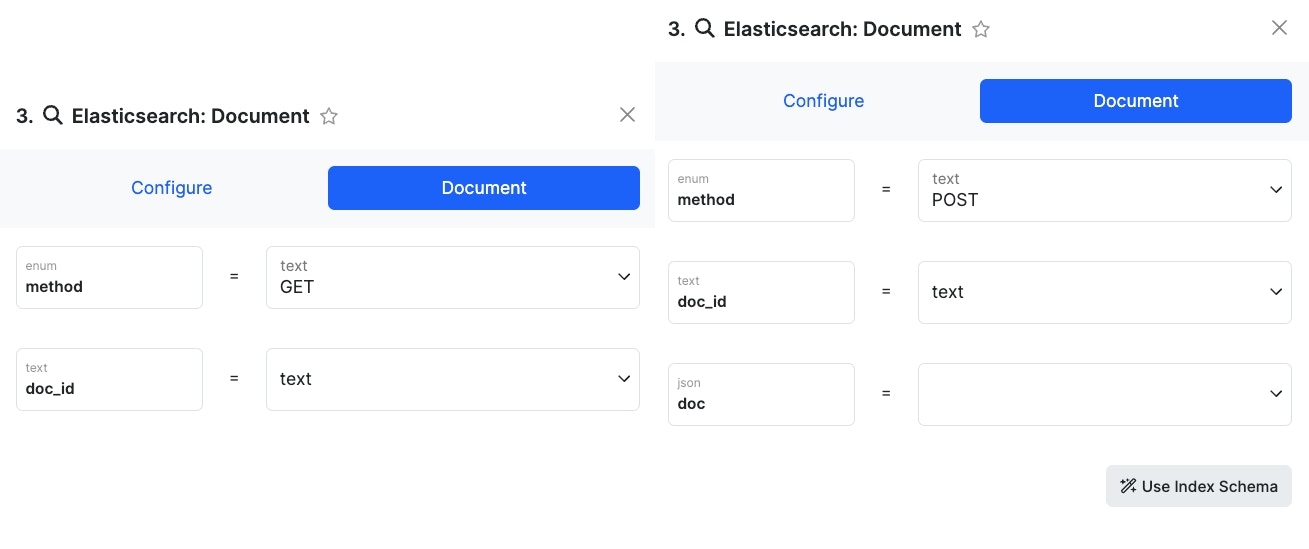
Elasticsearch Request
Send any Elasticsearch API request using similar configuration methods as outlined in Connect to Elasticsearch. Set theurl to use the desired endpoint of the request.
Set query to the JSON payload if necessary.
OpenSearch
OpenSearch is an open-source search and analytics tool suite, derived from ElasticSearch, offered as a scalable and flexible solution by Amazon Web Services. With OpenSearch, you can apply natural language processing, text analyzers, and built in machine learning to quickly return the most relevant data. This makes it a great tool for log analytics, application monitoring, and website searches.Connect to OpenSearch
Requires an OpenSearch Service domain hosted by AWS. Find AWS Documentation on Creating and managing Amazon OpenSearch Service domains.-
auth_type
Choose betweenIAM(AWS Identity and Access Management) andmaster(basic auth from internal user database) to set the type of authentication process to use. -
key_id
If usingIAM, enter the IAM key id you wish to authenticate with.
If usingmaster, enter the username you wish to authenticate with. -
access_key
If usingIAM, enter the access key you wish to authenticate with.
If usingmaster, enter the password you wish to authenticate with. -
region
Only required forIAM. Set to the configured OpenSearch region (example:us-east-2). -
base_url
Set to the domain endpoint (IPv4) specified on AWS. -
index
Enter the name of the OpenSearch index to send request. Only applicable on Document and Query functions.
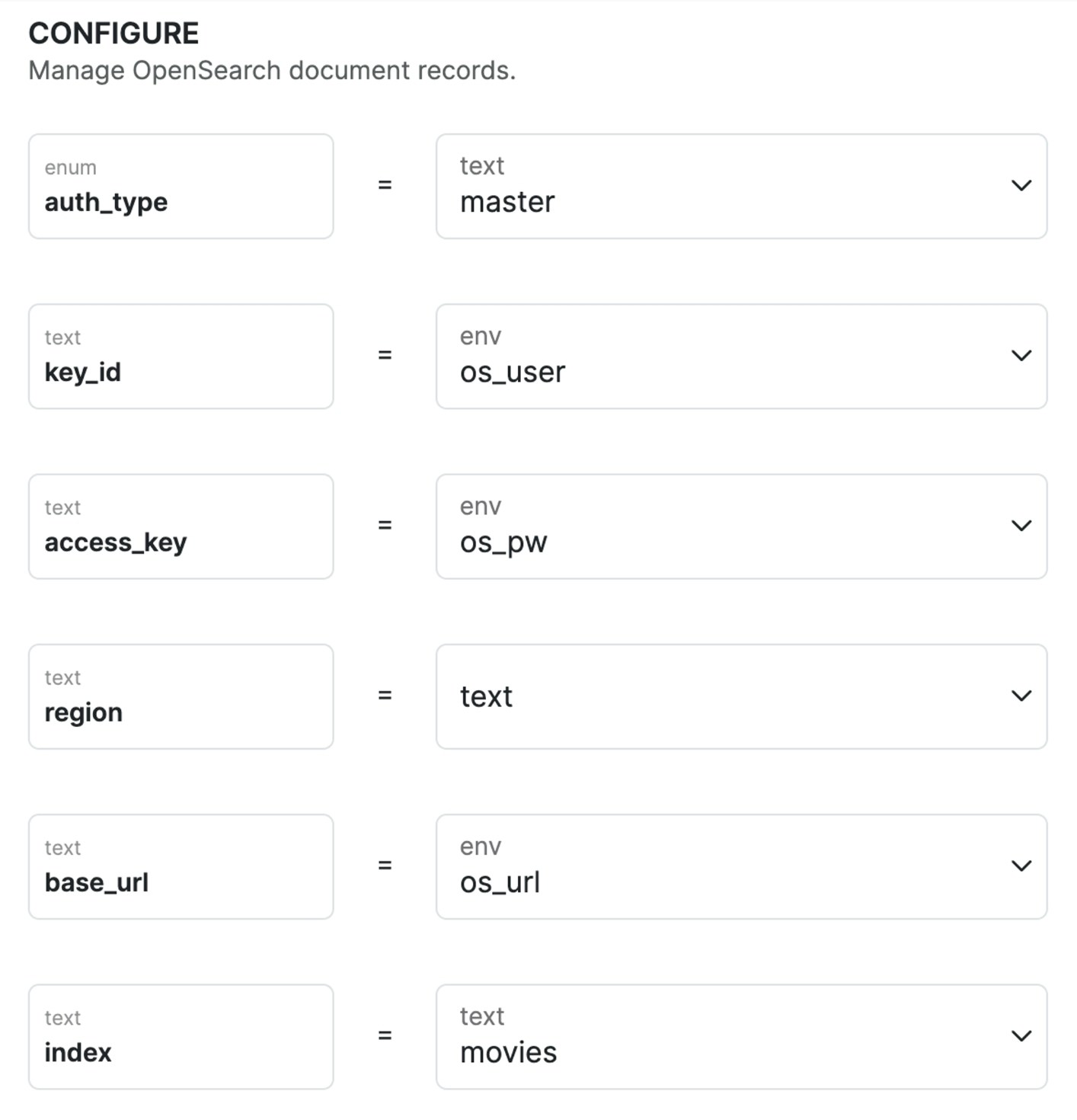
Configure OpenSearch connection using IAM or internal user database credentials.
AWS OpenSearch Query Wizard Function
Use the query wizard to easily search documents stored in OpenSearch.Configure
See Connect to OpenSearch for details on configuration. Then, select areturn_type from the options below.
search -Returns records that match querycount- Returns number of total records matching query
Query
Query Wizard Set filter criteria using the Xano query builder. The left input is the field to filter on. Then set the operator and value to evaluate. Optionally, add multiple conditions using AND / OR logic. Select ‘Update Payload’ to ensure your changes are reflected in the query payload.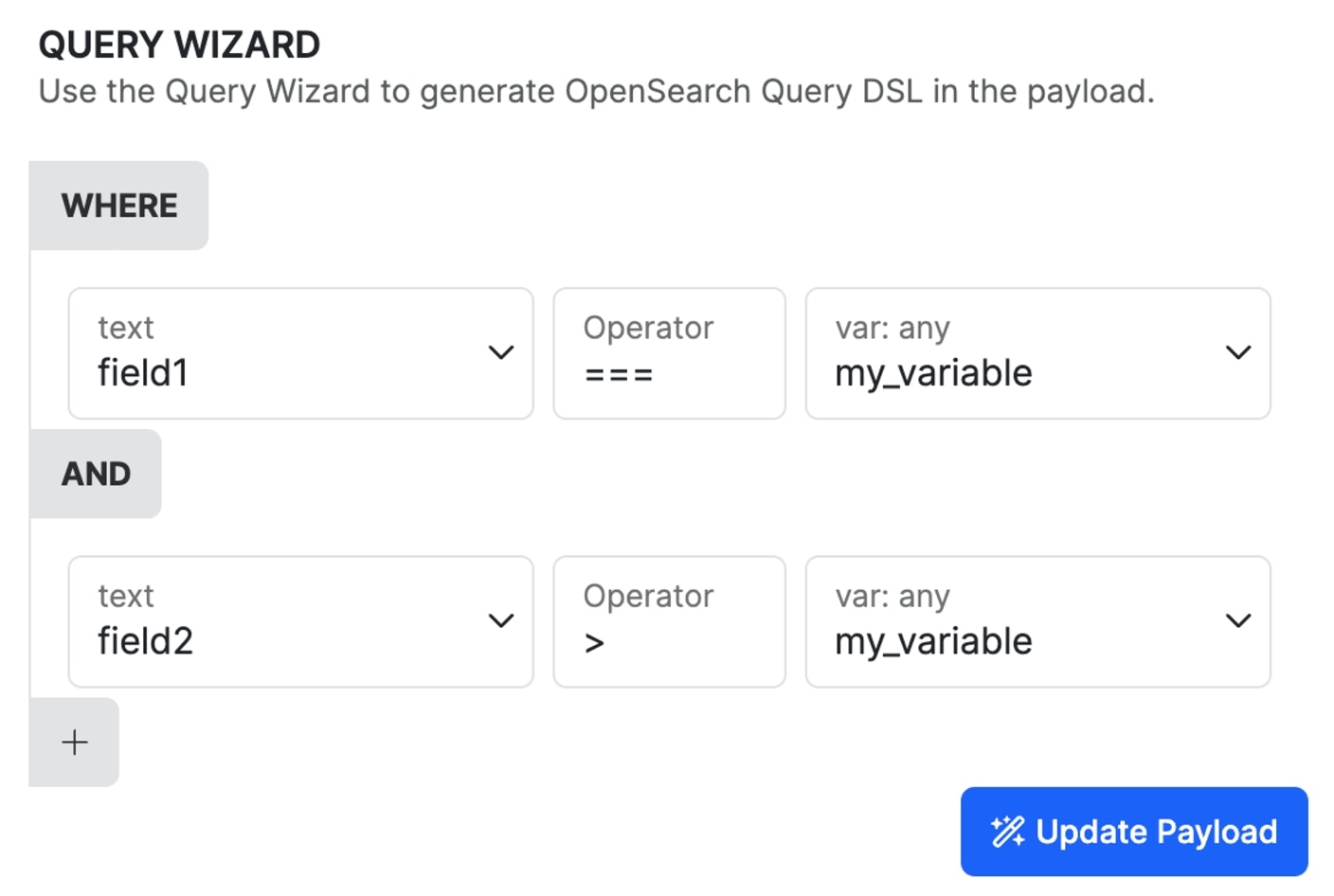


AWS OpenSearch: Document (CRUD) Function
Easily get, add, update, or remove documents from an OpenSearch index.Configure
See Connect to OpenSearch for details on configuration.Get Document
- Set method of API request to GET
- Specify doc_id

Create or Update Document
- Set
methodtoPOST(create) orPUT(update) - Set
doc_id(optional for POST) - Set document payload. Click ‘Use Index Schema’ if you want to import the schema (mapping) directly from the OpenSearch index set under Configure tab. This will use the credentials provided to make a request to OpenSearch on your behalf to get the mapping.
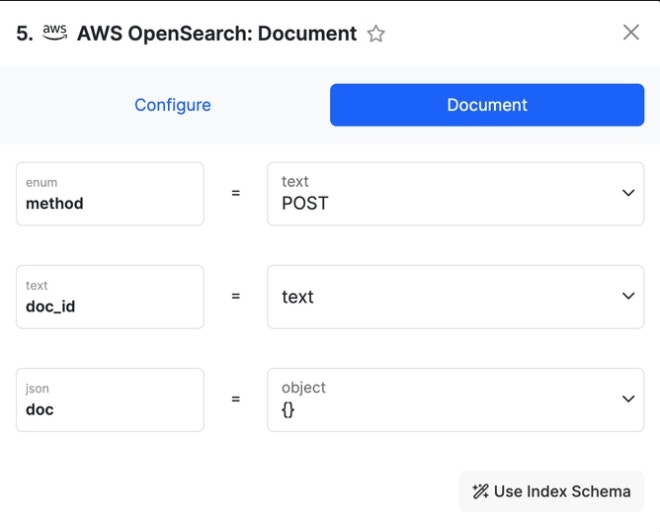
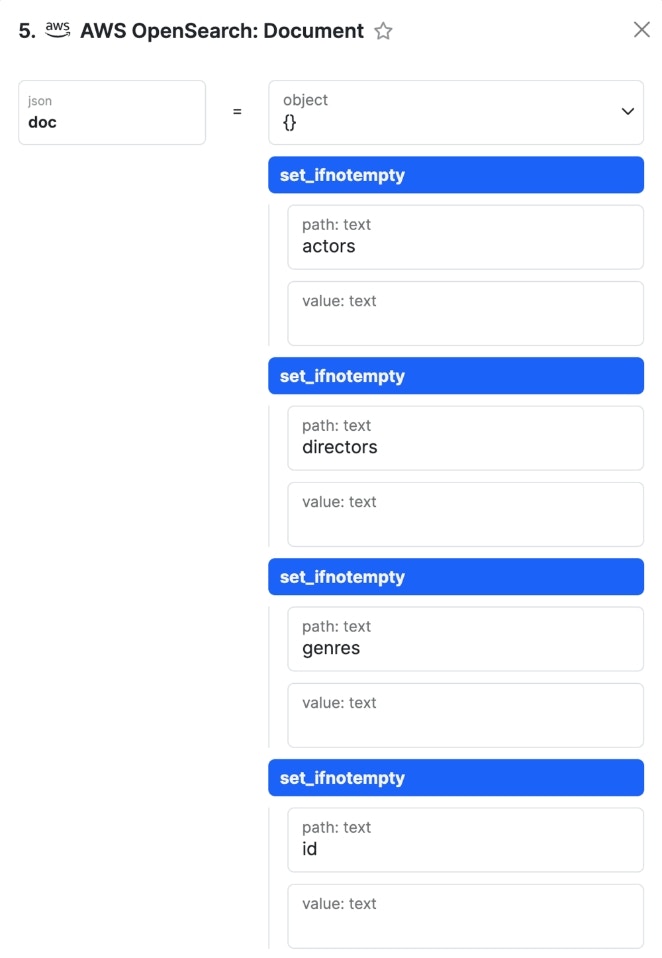
AWS OpenSearch Request
Send any OpenSearch API request using similar configuration methods as outlined in Connect to OpenSearch. Set theurl to use the desired endpoint of the request.
Set query to the JSON payload if necessary.
Google Cloud Storage
Manage Google Cloud Storage buckets directly in the Xano function stack.Google Service Account
You need to set up a Google Service Account in the Google Cloud Console. Navigate to IAM & Admin and select Service Accounts.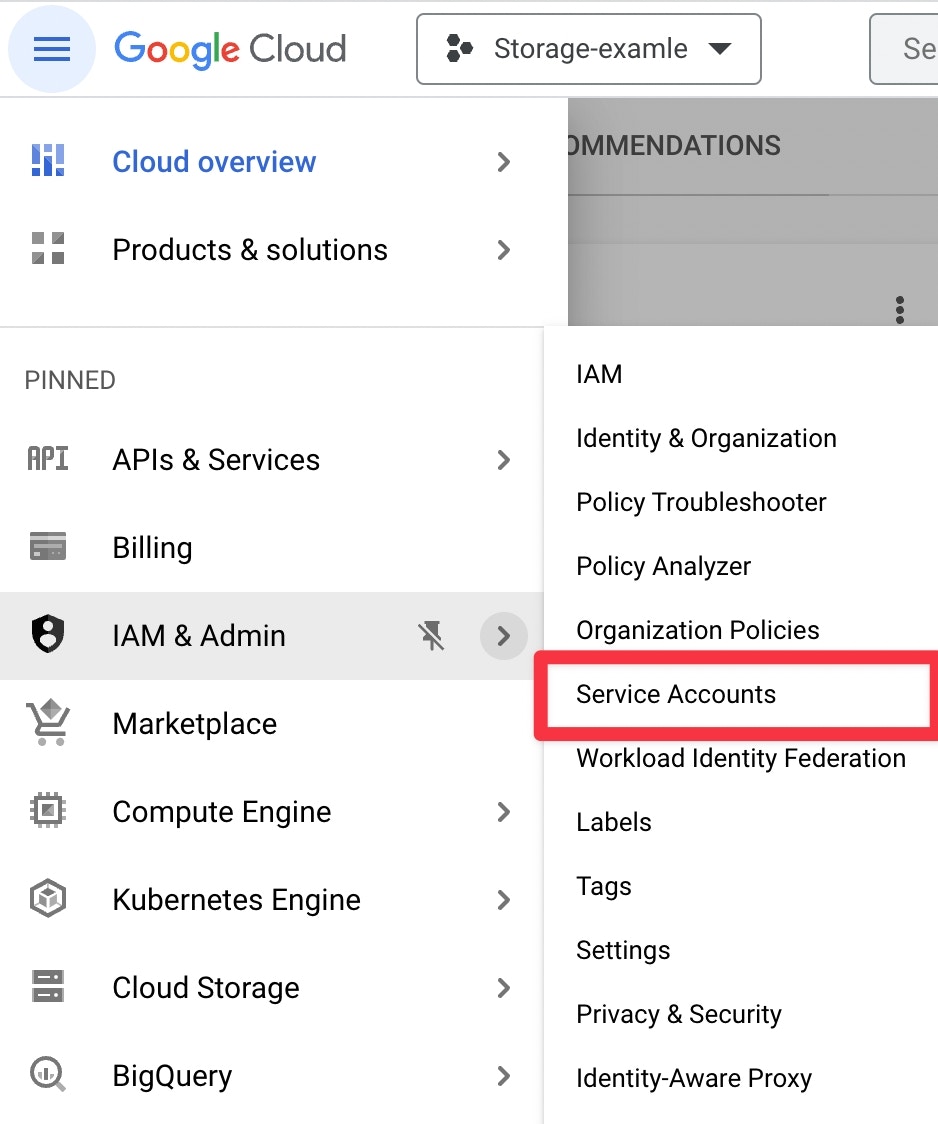
Roles
Once the Service Account is created, select actions and Manage keys. Then add a new key and select the JSON option.
The JSON key must be entered as a text string. Do not import the key as JSON when adding it to Xano.
List Directory
List the contents of a Google Cloud Storage Bucket.
Signed URL
Generate a signed URL to provide limited permissions. These can be used with a TTL (time to live) similar to an expiring token.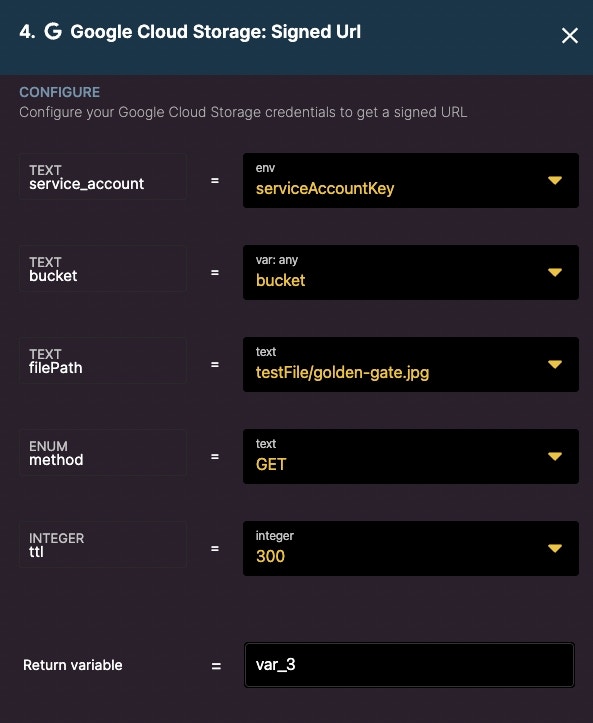
Upload a File
Upload a File to the specific Google Cloud Storage bucket.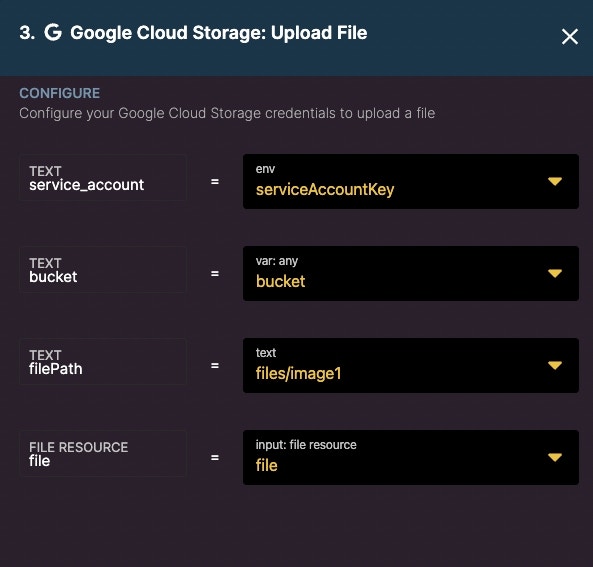
Delete File
Delete a specific file from a Bucket.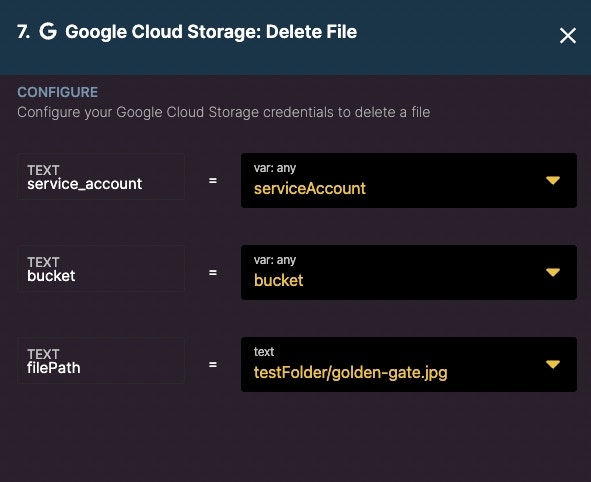
Create Variable From File Resource
Return the file resource as a variable in Xano, including the raw image. This can be used, for example, to send to another service if file transfer is needed.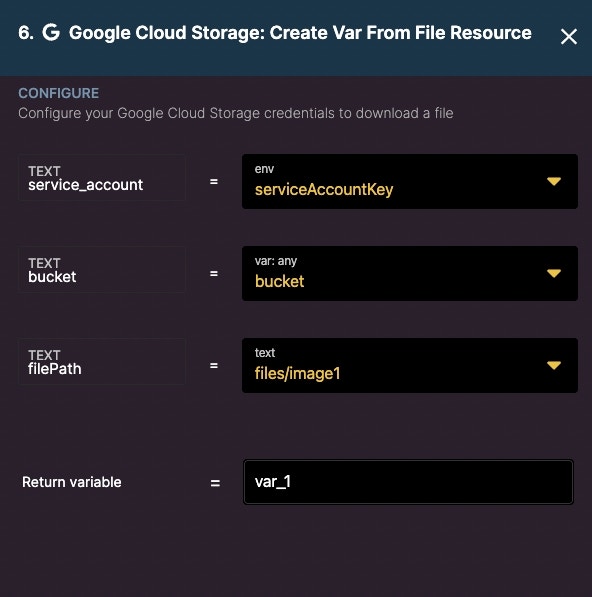
Example - Using the Variable Created from File Resource
Turn your API endpoint into a redirect to the file by returning the data field from the return variable and setting a custom header of Content-Type with the mime of the file resource.
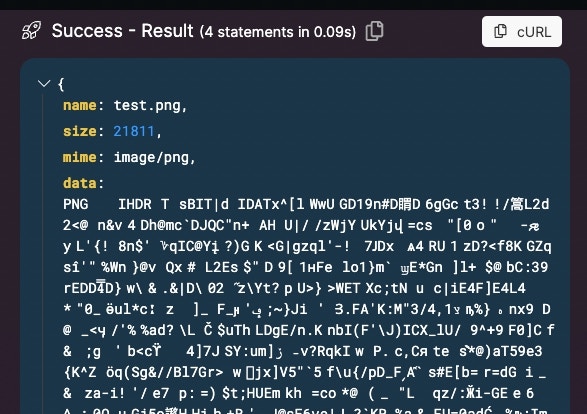
Content-Type the mime (in this example image/png). We can have our endpoint URL redirect to the file.
.gif?s=fd4ea95873e415fab1ffb6ab87b829e4)
Amazon S3
Access Key and Secret Access Key
From your AWS Developer Console, navigate to Security Credentials.

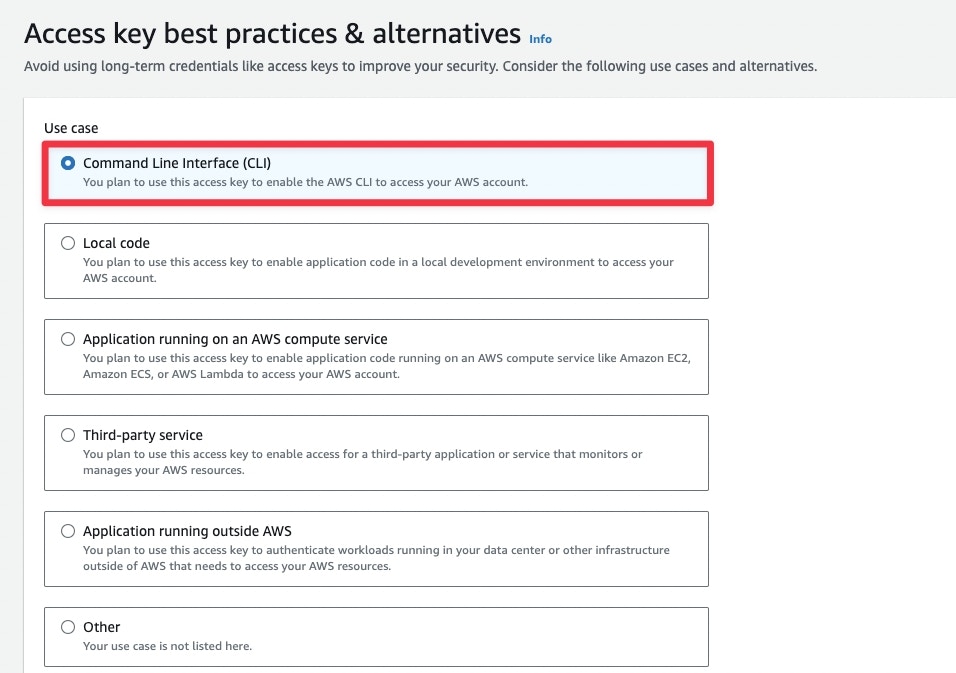
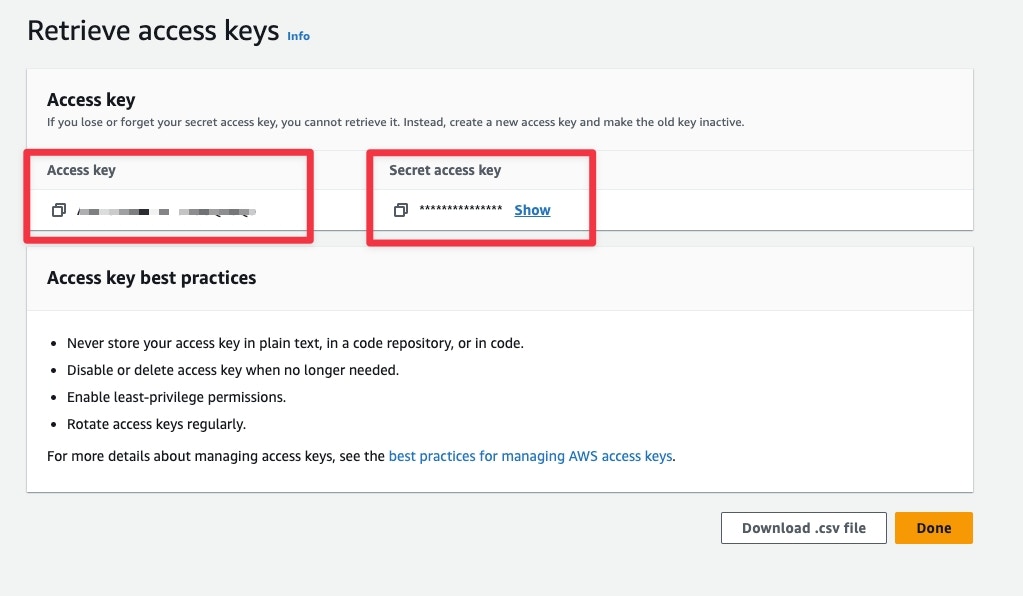
Bucket and Region
The s3 bucket name and region will also be required when calling the Amazon s3 Cloud Storage Functions. When navigating to your s3 buckets, the bucket name can be found under name. The region is under region but only requires the identifier. For example, in the below image the bucket name is xano-s3-test and the region is us-west-2.
Amazon S3: List Directory
Lists the directory details of the specific Amazon s3 bucket.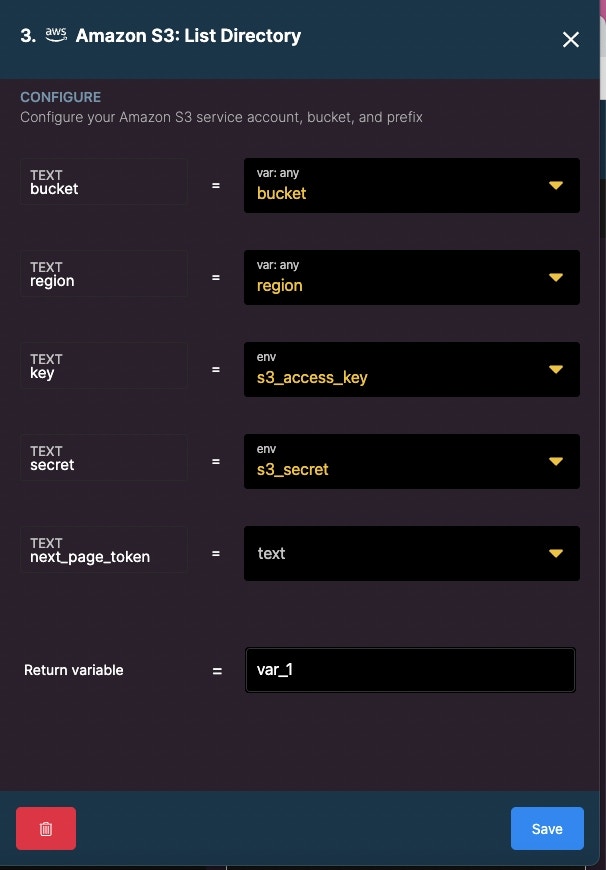
Amazon S3: Signed URL
Creates a signed URL of the file to be shared with an expiration.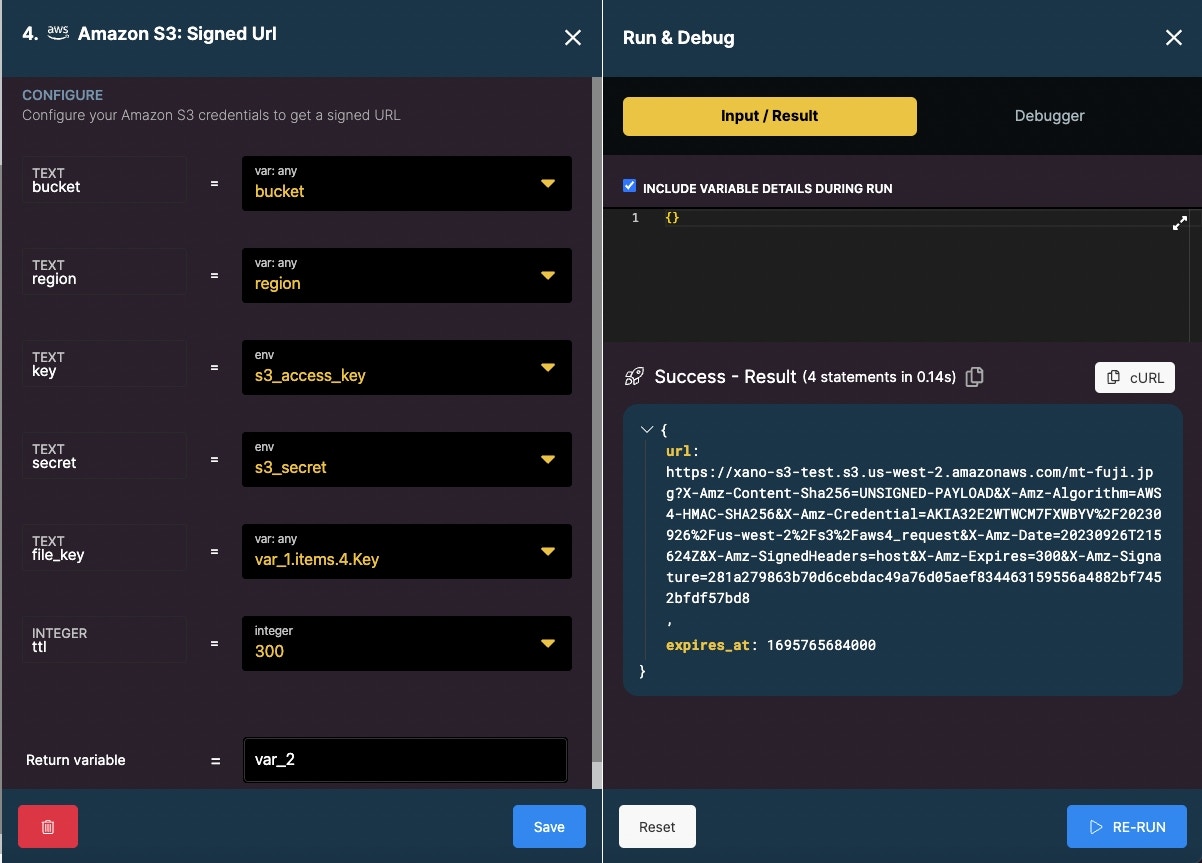
Amazon S3: Upload a File
Upload a file to a specified Amazon S3 Bucket
Amazon S3: Delete File
Delete a file from a specified S3 Bucket.
Amazon S3: Create Var From File Resource
Return the file resource as a variable in Xano, including the raw image. This can be used, for example, to send to another service if file transfer is needed.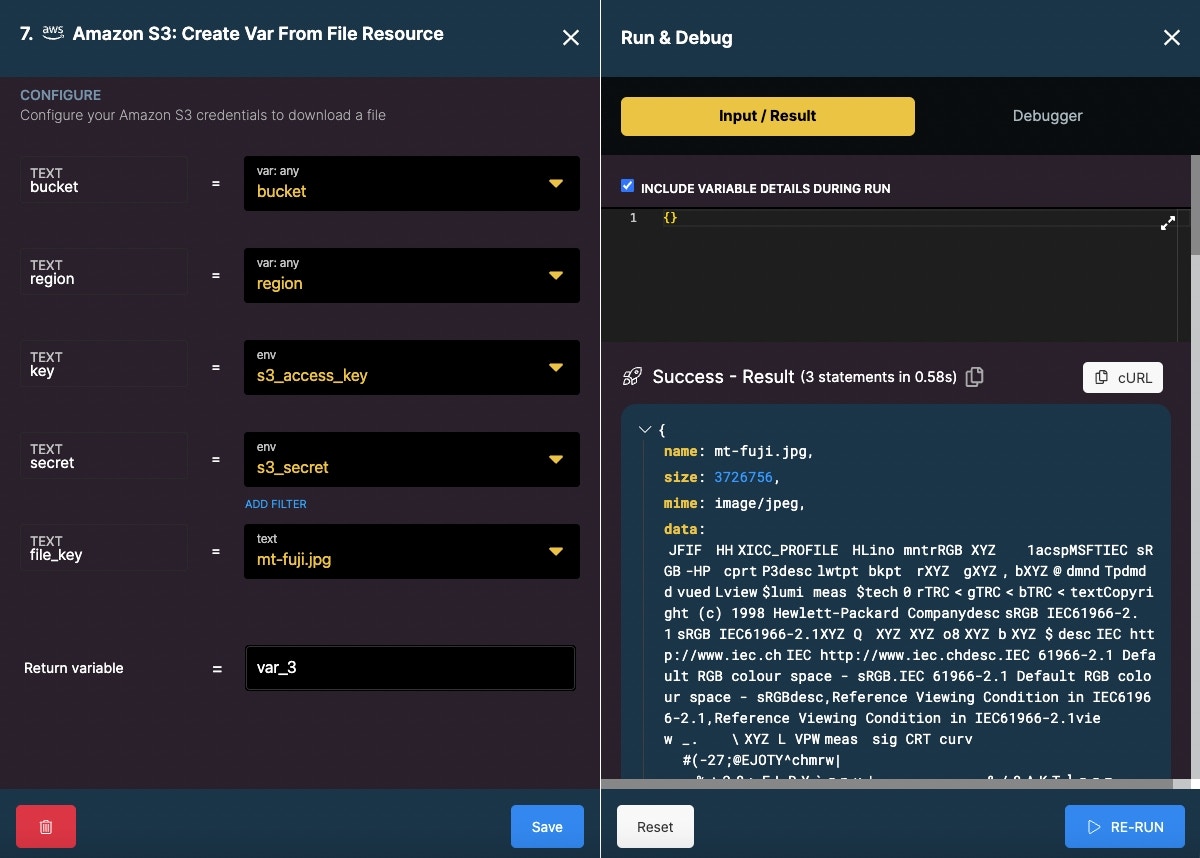
Microsoft Azure Blob Storage
Manage storage containers from your Microsoft Azure account directly from the Xano function stack.Setup
Please ensure you have a Microsoft Azure account. If you don’t yet have an account sign up to Microsoft Azure and navigate to the Azure portal.Create a storage account
A storage account is required to store files on Azure. First, select Create a resource from the portal homepage.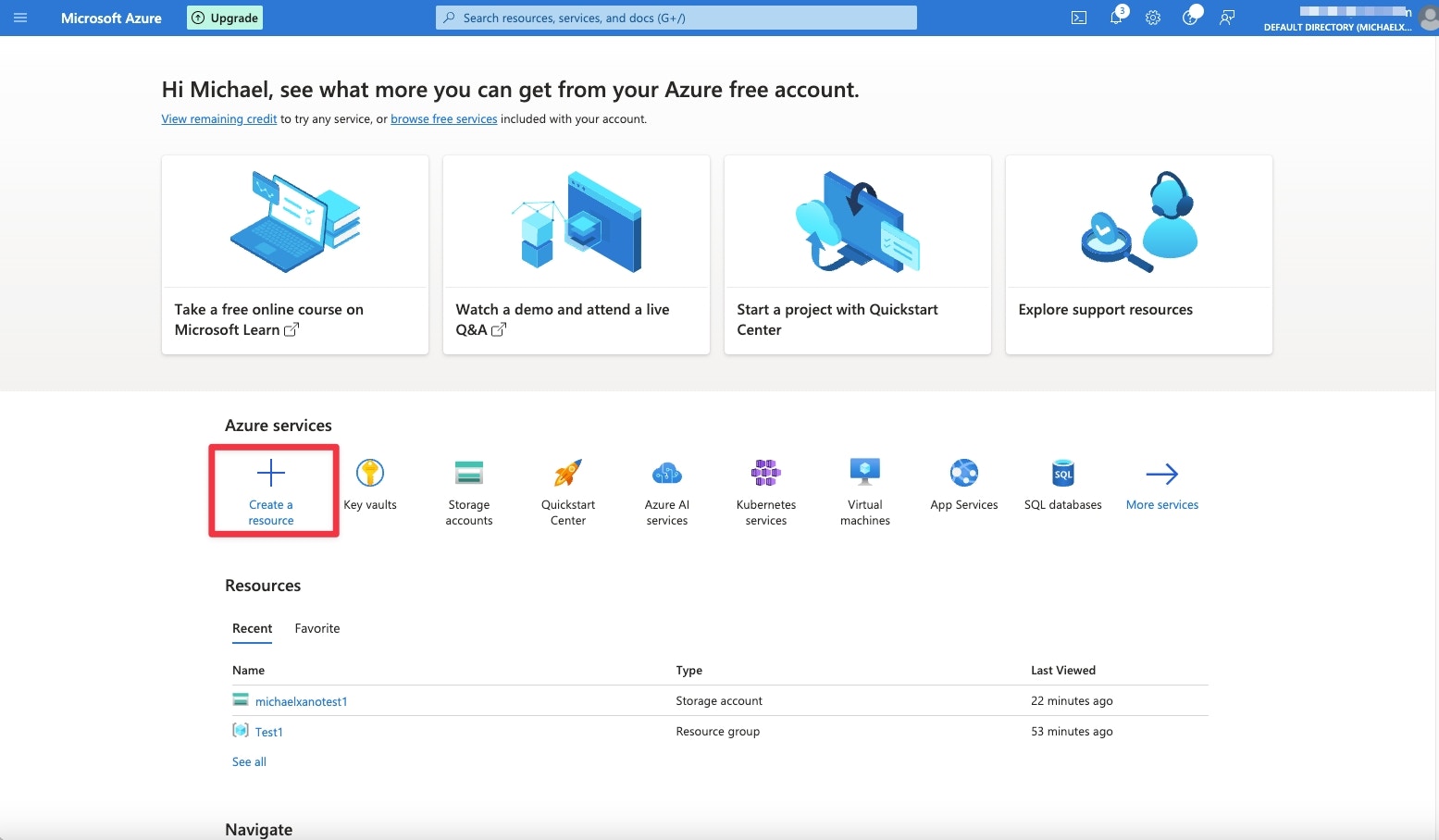
Select Create a resource from the portal home page.
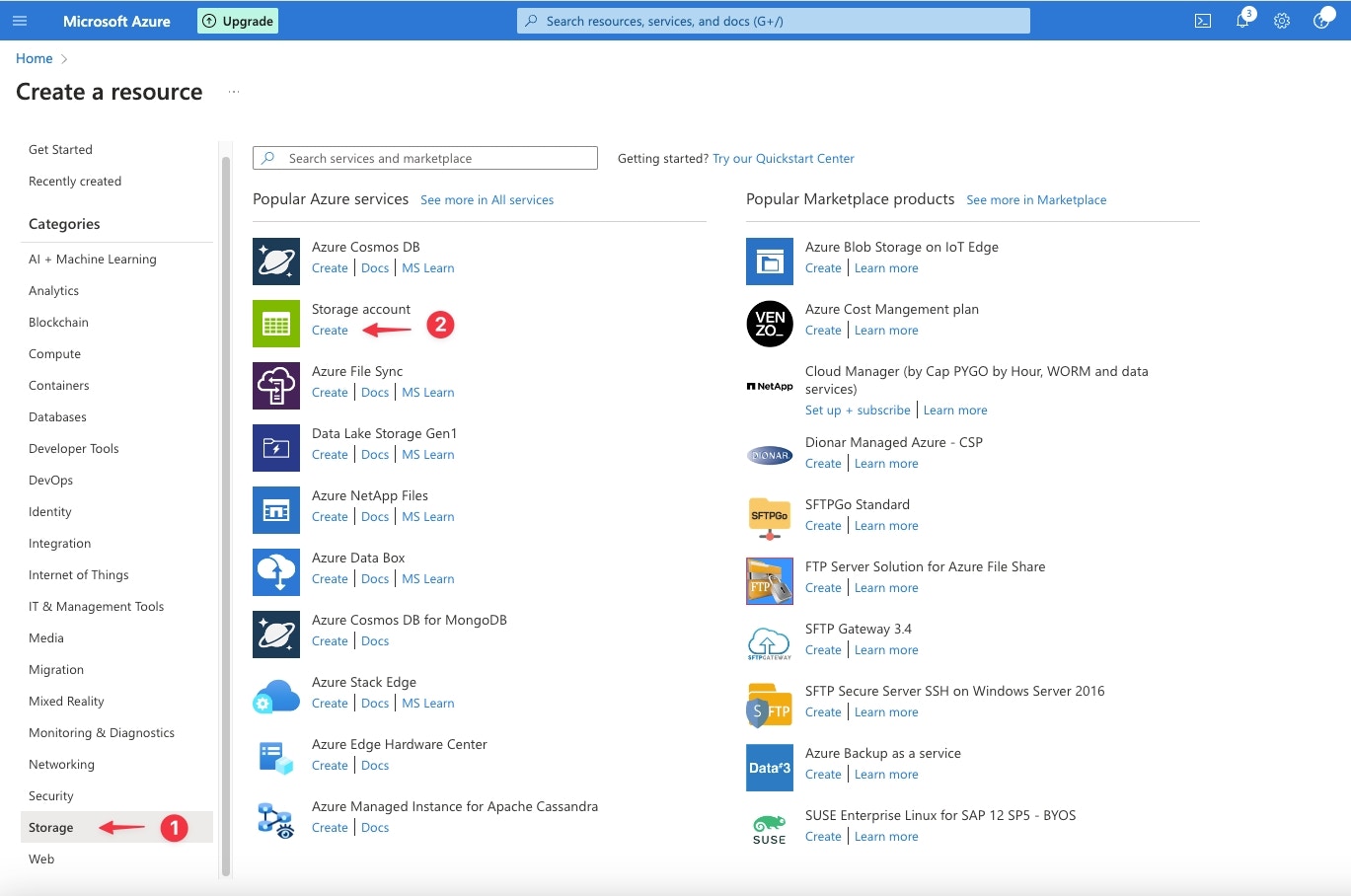
Create a storage account.
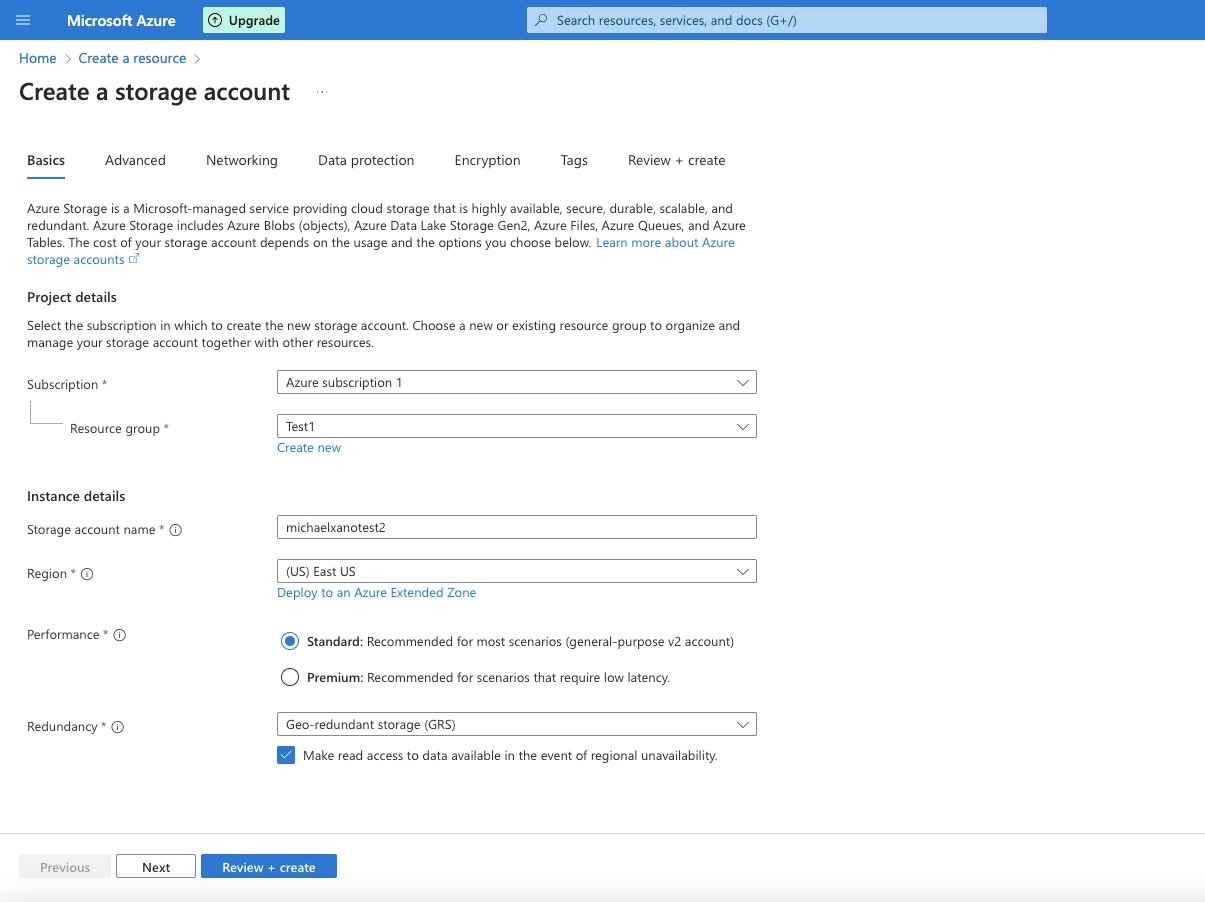
Create a storage account.
Create a container
Once the resource is deployed, navigate to containers and create a new container.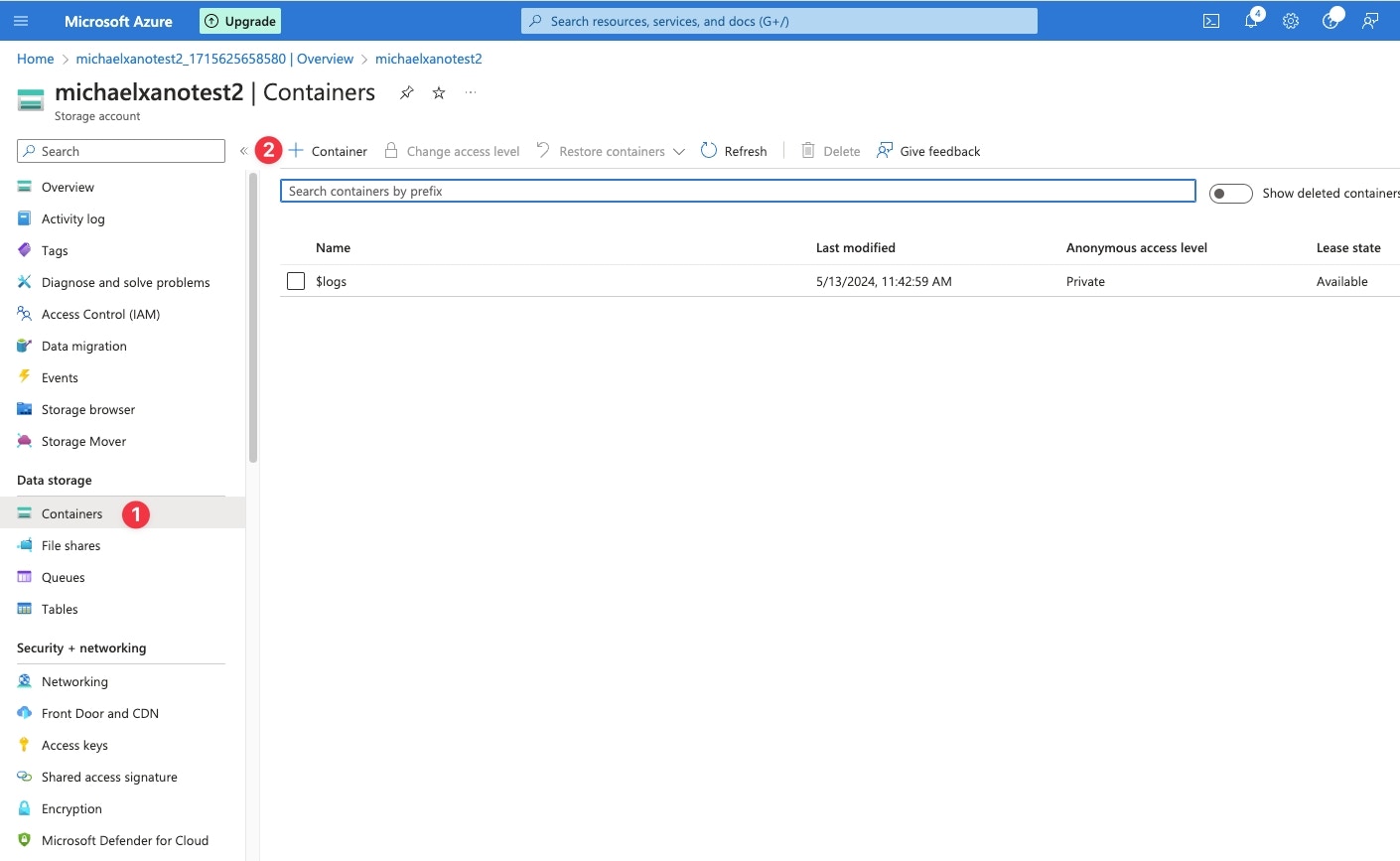
Create a new container.
Access key
After creating a container, you need to retrieve your account access key to use the Azure functions in Xano. Find Access keys under Security + Networking on the left navigation bar. Select Show next to Key under key1. Copy the key and store it as an Environment Variable in Xano.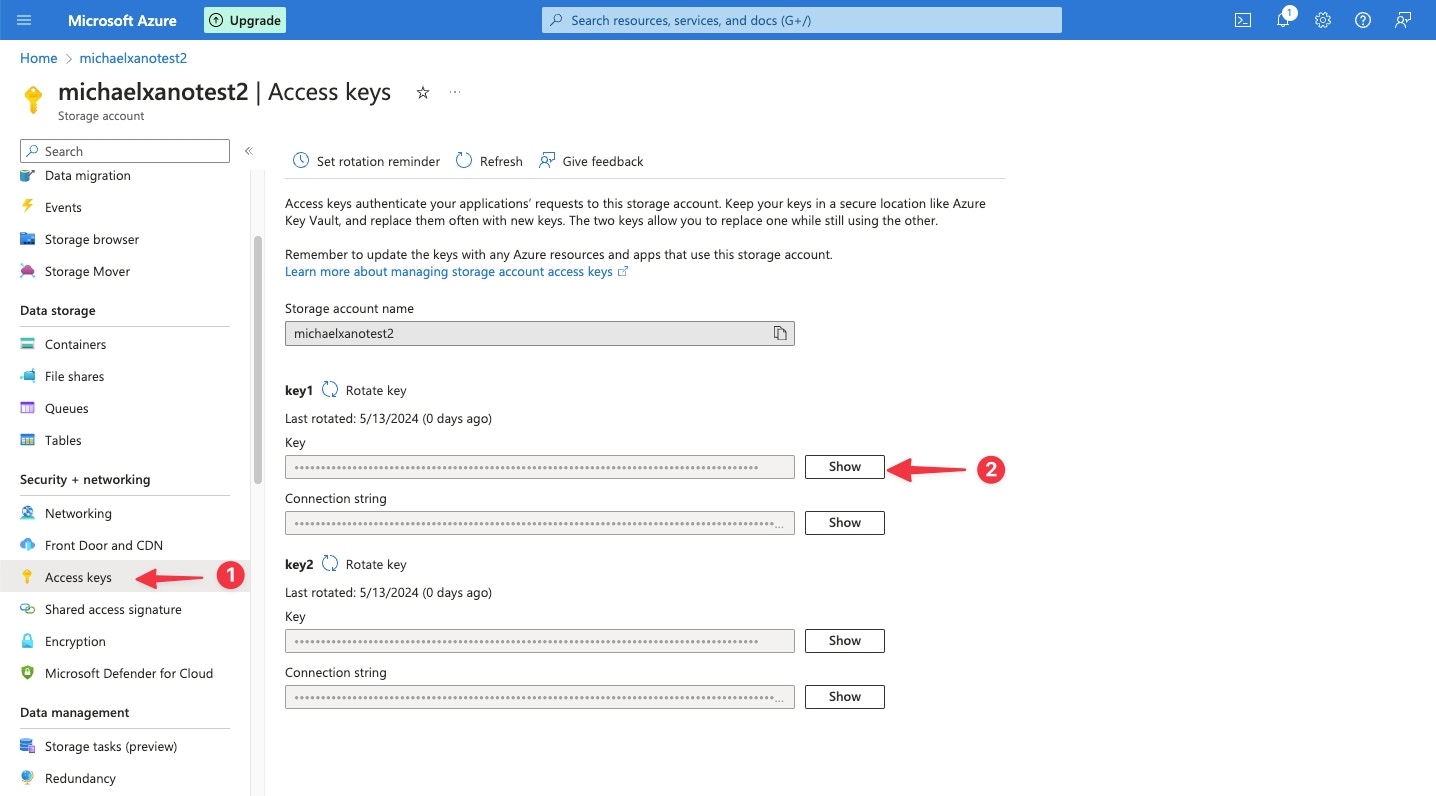
Locate your Azure Access Key.
Do not share your access key. It is recommended to store your access key as an Environment Variable in Xano for safe keeping.
List Directory
List directory will list the blobs, properties, and metadata in a container or at a specified path within the container.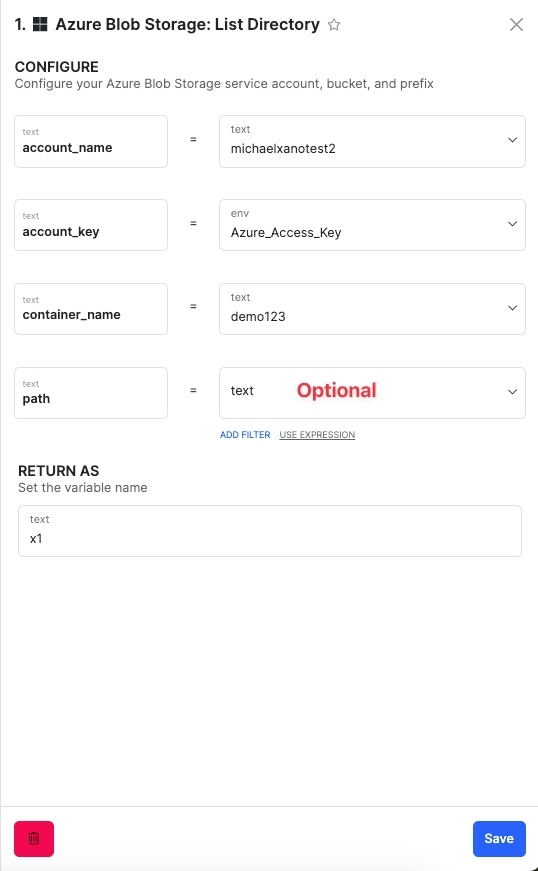
List the Azure Directory.
- account_name - Azure storage account name.
- account_key - Azure Access Key.
- conatiner_name - Container name within Azure storage account.
- path - (Optional) Use this to specify a specific blob or folder within a container.
Signed URL
Creates a signed URL for a file with a specified time to live (TTL) or expiration.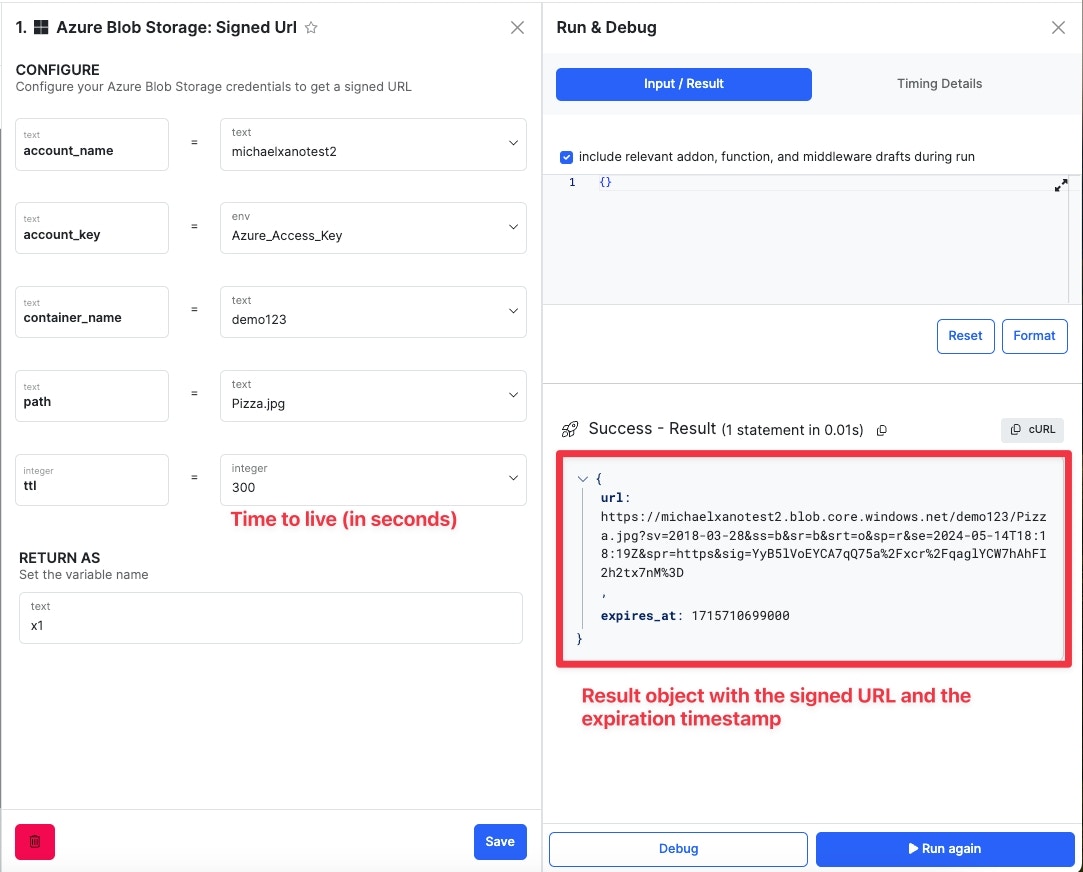
Create a signed URL for an Azure blob.
- account_name - Azure storage account name.
- account_key - Azure Access Key.
- conatiner_name - Container name within Azure storage account.
- path - The path of the file to create a signed URL for.
- ttl - Time to Live (in seconds); how long the signed URL is accessible.
Upload a File
Upload a file to an Azure blob container.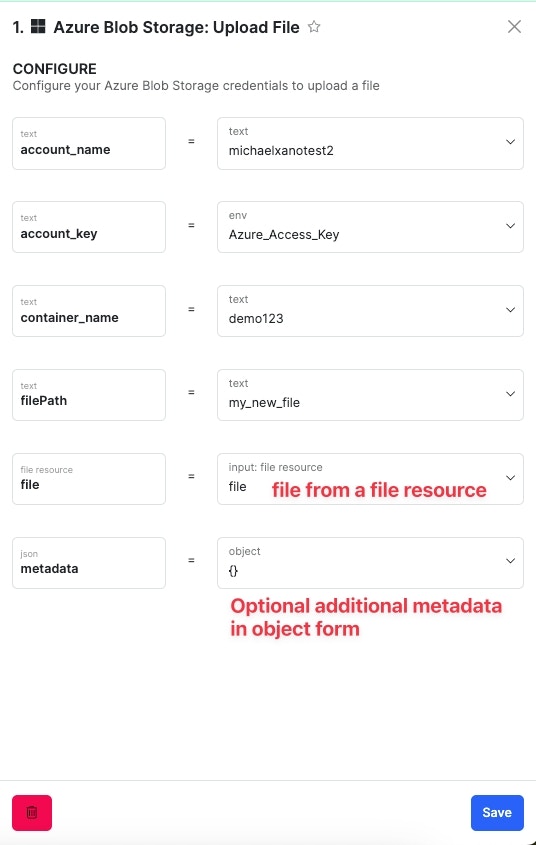
- account_name - Azure storage account name.
- account_key - Azure Access Key.
- conatiner_name - Container name within Azure storage account.
- filePath - The path name for the file being uploaded.
- file - The file being uploaded. This must come from a file resource.
- metadata - (Optional). Optionally include additional metadata with the file stored in object format.
Delete a File
Delete a file from an Azure blob container.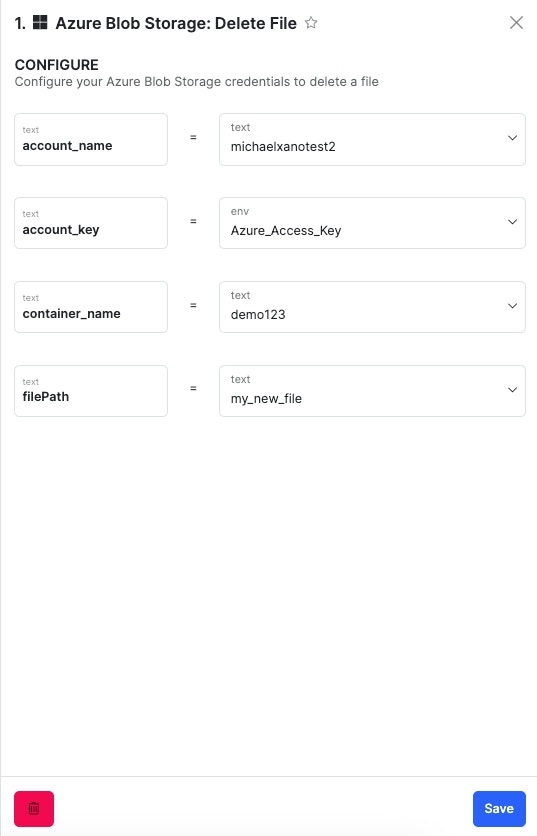
Delete a file from an Azure blob container.
- account_name - Azure storage account name.
- account_key - Azure Access Key.
- conatiner_name - Container name within Azure storage account.
- filePath - The path name for the file being deleted.
Create Variable From File Resource
Create a variable from a file resource in Azure to use it in the Xano Function Stack.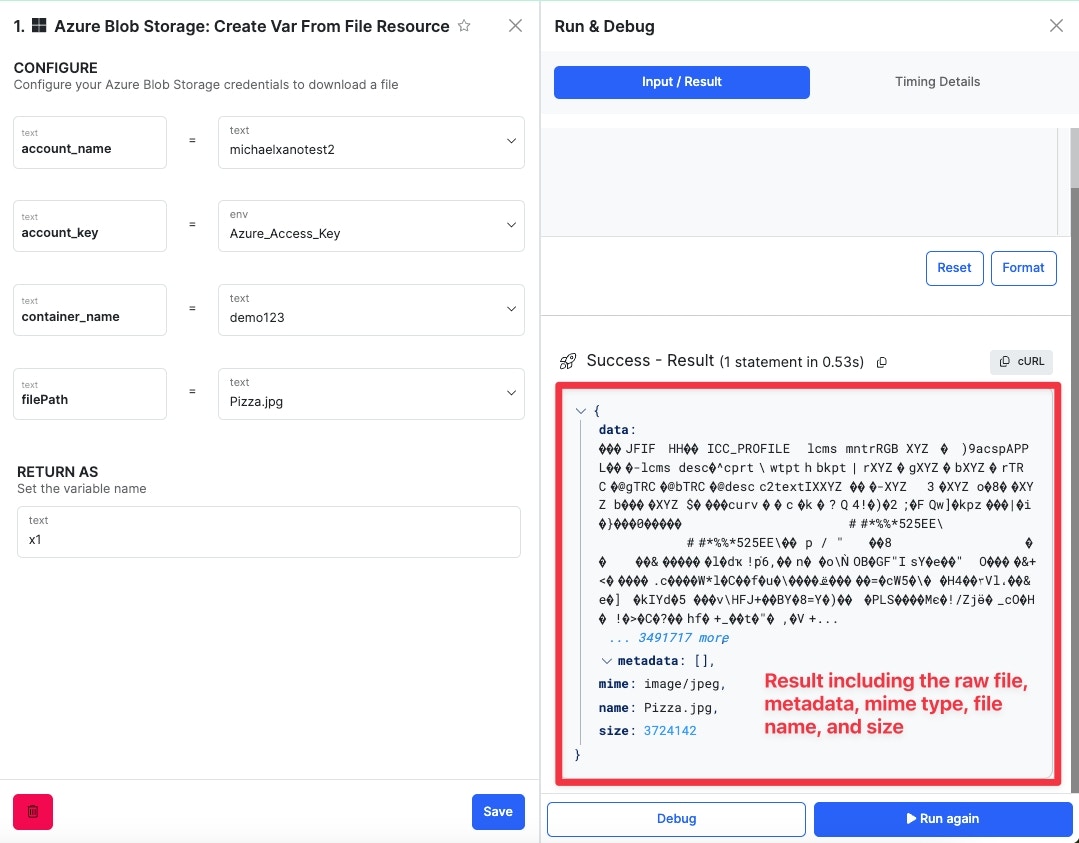
- account_name - Azure storage account name.
- account_key - Azure Access Key.
- conatiner_name - Container name within Azure storage account.
- filePath - The path name for the file being created as a variable.
Check out the example above of leveraging the Variable from File Resource in the Function Stack.
Get File Metadata
Get the metadata of a file from an Azure blob container.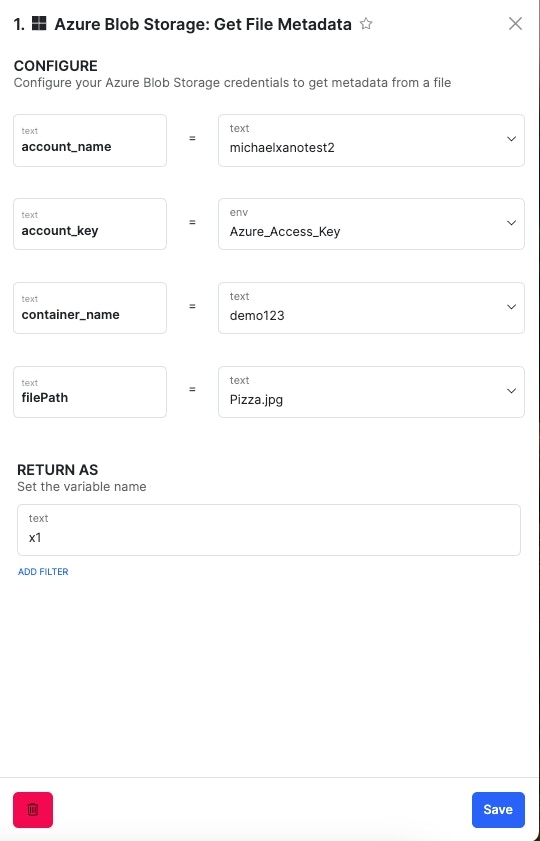
Retrieve the metadata from a Azure storage blob.
- account_name - Azure storage account name.
- account_key - Azure Access Key.
- conatiner_name - Container name within Azure storage account.
- filePath - The path name for the file to retrieve the metadata from.